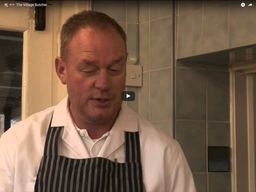By Museum of the Broads
Location: MarthamSource Description: Website of videosSource Author: Various schoolchildren, in conjunction with Media Projects EastEdition Statement: Publication Statement: http://www.mediaprojectseast.co.uk/martham/contact/index.htmlDate of Original: Date of Collection: Copyright: Media Projects EastInterviewer
Hello, we’re here with Phillip Dowe, the village butcher, and…well, it’s quite a shop! How long has this been a butcher’s, Phillip?Phillip Dowe
Well it’s certainly been butcher’s for 100 years, Neil. It was built, I think, about 120 years ago, but it’s certainly been a butcher’s for 100 years.Interviewer
And how did it come to be built here?Phillip Dowe
Well I think they just decided, there was farm and family in the same village, under the same name Chapman’s, and they wanted to sell some of their produce, their cattle, and they built it on the side of the house, literally built it—I don’t suppose there was planning then—and they built it so that the sun was behind it all day, the sun didn’t come in the windows, and they started selling meat from here.Interviewer
Did they always have windows? Or did they have shutters, do you think?Phillip Dowe
They certainly had windows, and the windows came out. These were the window-panes, and they would be in there like that, and they would take the first one out, slide the next one, slide the next one, stand them there, and then fill the window up with meat. And as you can see you’ve got your pork in there, you’ve got your lamb, you’ve got your chickens: they’ve put on a real show there. And it could have been a show for Christmas, because they’ve really gone to town. And you’ve got your little chap here, he wouldn’t have been doing any work I think, but they’ve decked him out for it. And that it one of the Chapman family there, who had that originally.Interviewer
And that’s his wife, would she have worked in the shop?Phillip Dowe
No, that wasn’t his wife, that was his mother, that was old Mrs. Chapman. And the pork as you can see had quite a bit of fat on it.Interviewer
Cor! Would that crisp?Phillip Dowe
You had meat with your fat, rather than fat with your meat!Interviewer
So where did you learn your trade?Phillip Dowe
Well I started here as a Saturday boy in about 1978, and your job was putting fresh sawdust down, sweeping up the old, and doing the jobs nobody else wanted to do, washing up the mincer, and Mr. Chapman very kindly said if I wanted to leave school I could have a fulltime job, and I went from there. And in 1996 when he retired I had a chance to buy it off him and nw we’re in 2013 and we’re still doing the same thing. But then it was very much more hands on, you melted your own fat down to make dripping, your pork cheeses, you manufactured everything on the premises really.Interviewer
Would you go round on a bike, or a van…?Phillip Dowe
There was a big thing then in rounds. Lot of competition, people go round, come with us, come on our round, and once they came on your round you’d have to look after them. And going back a while, pony and cart, and they had their own pony, and what they’d call ‘gigs’, and that was a big job. They’d go out, they’d take the orders, and come back, they’d have to brush the horse, feed the horse, clean the cart down, all the wicker baskets had to be washed…so there was a lot of work involved. And of course, some butchers, not all but this one had their own slaughterhouses, so that was a lot of work, and they would do two markets a week, they would go to Great Yarmouth market, which taking meat on a horse and cart was in itself a big job, you’ve got to trundle all the way there, and come back and put the horse to bed. I heard a story once, a lad was up there, they’d take a lad with them for the day, and a lady wanted a certain cut of meat, and they made him come home from Yarmouth, go get a certain cut of meat and bring it up on horse and cart to keep the lady happy.Interviewer
Mr. Chapman, was he one of the founders?Phillip Dowe
His grandfather I think was the first person to have it. Old George Chapman. Mr. Chapman who I worked for was George Chapman, but he was grandson, and I also knew his father, Ted Chapman, who’d had it in the war, and it was very hard, rationing was about then, I think meat rationing went on until well into the middle 50s, so it was a very hard time for butchers then. And I think George, he might have told you different, but I think he might have had it in the good times, the 60s, 70s, 80s, when everybody basically shopped in the village.
(outside)
Well there we are Neil, that’s the smokehouse, which had smoked bacon, hams, sausages and various things through the ages.
